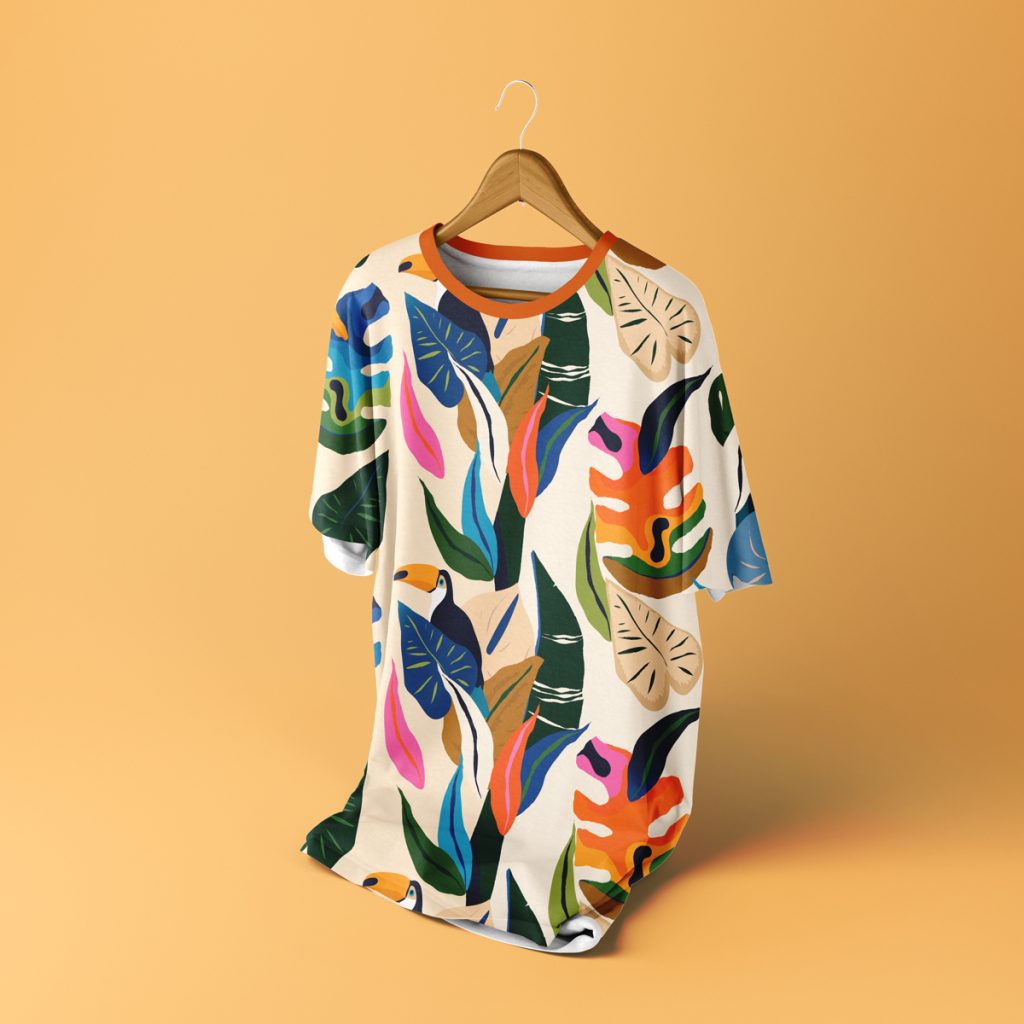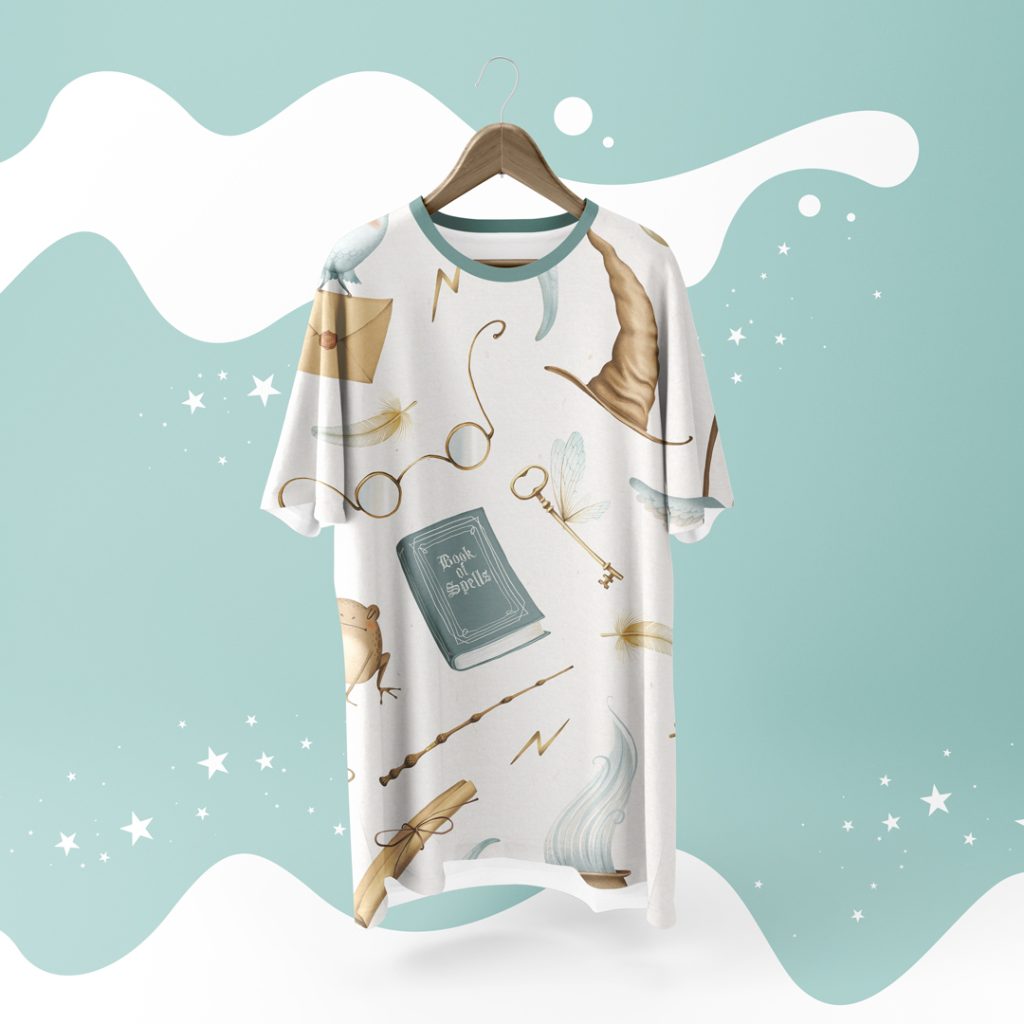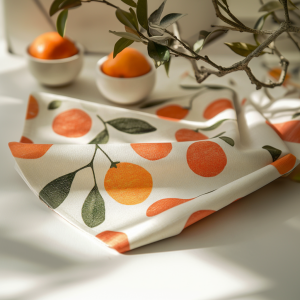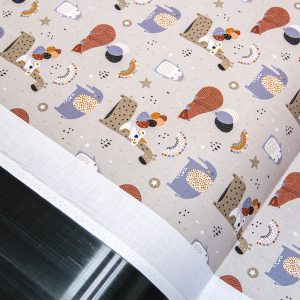Starting your own T-shirt printing business can be a profitable venture if you plan each step carefully. From selecting materials to printing techniques to sales strategies, every element matters. In our article, you will learn how to calculate potential earnings per T-shirt, taking into account production costs, sales prices, and key marketing aspects. Learn how to effectively manage your T-shirt business to achieve maximum profit.
Table of Content
- T-shirt business – where to start?
- What is needed to print t-shirts?
- What fabric to choose for t-shirt printing?
- What is the best way to print on T-shirts?
- How much does it cost to print T-shirts?
- Tips to help you sell printed T-shirts
- How much can you earn per T-shirt?
- T-shirt business – summary
T-shirt business – where to start?
Starting your own t-shirt printing business requires a thoughtful approach and a good plan of action. The first step is to come up with an idea for your T-shirts – it’s worth considering what will make your products stand out from the competition. Will it be unique designs, motifs related to local culture or maybe personalised bespoke prints? It’s also a good idea to analyse current fashion and graphic design trends to understand what designs and styles are currently most in demand. Inspiration can be found on platforms such as Pinterest or Instagram, as well as in trade magazines.
The next step is to prepare a detailed business plan. This should include several key elements:
- Market analysis: Research what the current trends are, who your competitors are, and the needs and preferences of potential customers. It is worth conducting market research to help identify gaps in the market and opportunities that can be exploited.
- Identify your target audience: Identify who you are targeting with your products. Will it be young people, fashion lovers, athletes or perhaps families with children? Knowing your target group will allow you to better tailor your offer and marketing strategy.
- Develop a marketing strategy: Think about how you will promote your t-shirts. Online marketing plays a key role nowadays, so invest in social media activities, SEO, as well as paid advertising on platforms such as Facebook or Google Ads. Also consider working with influencers who can help increase your brand’s reach.
- Sales channels: Think through where you will sell your t-shirts. There are many possibilities – from your own online shop, to e-commerce platforms such as Etsy, Amazon or eBay, to stationary sales at local fairs, festivals or boutiques. Each sales channel has its advantages and disadvantages, so it’s worth choosing the ones that best suit your business model and marketing strategy.
- Logistics and stock management: Consider how you will manage production and supply. Will you print the T-shirts yourself or will you outsource? How will you store and manage stock? Adequate organisation of logistics and stock management is crucial to ensure smooth operations and timely deliveries to customers.
- Funding and budget: Think through what your initial and operating costs will be. This includes the purchase of materials, printing equipment, marketing costs, and any rental fees for warehouse space or a shop. Determining a budget and finding sources of funding (e.g. savings, loans, investors) is essential to getting your business off the ground and moving forward.

What is needed to print t-shirts?
To print t-shirts you will need the right materials and equipment. First and foremost, you need to choose the right type of material for your T-shirts. The most popular choice is cotton, due to its durability, wearing comfort and excellent ink absorption properties. Other materials include polyester, which is ideal for sports shirts, and cotton/polyester blends, which combine the advantages of both fabrics.
Next, it is necessary to prepare attractive designs that will attract customers. You can do this in several ways:
- Self-design: If you have graphic design skills, you can create designs yourself using graphic design software such as Adobe Illustrator or Photoshop.
- Hiring a graphic designer: You can hire a professional graphic designer to create unique bespoke designs. This solution may be more expensive, but it allows you to get professional and polished designs.
- Using pre-made designs: There are many platforms where you can buy or download ready-to-print designs. This is a quick way to add attractive graphics to your offer.
What fabric to choose for t-shirt printing?
Choosing the right fabric is crucial to the success of your t-shirt business. The most popular and versatile material is cotton. It is durable, comfortable to wear and accepts different types of prints well, making cotton t-shirts ideal for everyday use and very popular with customers. Cotton is also breathable and natural, making it more comfortable to wear, especially on warmer days.
Advantages of cotton:
- Durability: cotton T-shirts are resistant to wear and tear and repeated washing, which increases their lifespan.
- Comfort: Cotton is soft and pleasant to the touch, making shirts made from it comfortable to wear all day long.
- Versatility: Cotton accepts different types of printing well, such as screen printing, DTG or thermal transfer, giving you great flexibility in designing your designs.
- Eco-friendly: By choosing organic cotton, you can attract customers who care about the environment, which is increasingly important in today’s market.
Other fabrics:
If you plan to sell sports jerseys, technical fabrics such as polyester are worth considering. Polyester has several characteristics that make it an excellent choice for sportswear:
- Moisture wicking: Polyester wicks moisture away from the skin better, keeping sports jerseys dry and comfortable even during intense exercise.
- Flexibility: Polyester is more stretchy than cotton, providing greater freedom of movement during sports.
- Quick-drying: Polyester shirts dry faster than cotton shirts, which is important for frequent washing and wearing.
Material blends:
In addition to pure cotton and polyester, blends of these materials are also worth considering. T-shirts made from a blend of cotton and polyester combine the benefits of both fabrics:
- Comfort and durability: A cotton/polyester blend can be more comfortable than pure polyester, while offering greater durability than pure cotton.
- Easier care: blended shirts are less prone to shrinking and creasing, making them easier to care for.
- Versatile: Blended fabrics can be used for a variety of garments, from everyday shirts to more specialised sportswear.
Other specialised fabrics:
Depending on your specific market needs, you may also want to consider other materials such as:
- Lycra/Spandex: Adding Lycra or Spandex to cotton or polyester can increase the elasticity and comfort of shirts, which is particularly important in sports and fitness clothing.
- Bamboo: Bamboo fibre material is eco-friendly, soft and has natural antibacterial properties, making it an interesting alternative to cotton.
In summary, for most small businesses that focus on shirts for everyday wear, cotton will be the best choice. It offers comfort, durability and versatility, making it an ideal material for a wide range of prints and designs. However, if you are planning to expand into sportswear or speciality garments, other materials such as polyester or fabric blends are also worth considering to meet specific market requirements.
What is the best way to print on T-shirts?
There are several popular methods of printing on T-shirts, each with its own specific characteristics:
DTG (Direct to Garment) printing
DTG printing is a technique that involves printing directly onto fabric with ink. It is perfect for intricate, multi-coloured designs, as DTG printers can accurately reproduce fine details and colour gradients. One of the main advantages of this method is that it does not require the preparation of dies, so it is more flexible for smaller orders. This means you can easily print single t-shirts or small runs without incurring additional costs. DTG printing works best on cotton T-shirts, which absorb ink well.
Sublimation is a printing technique that works best on polyester materials. The process involves transferring special dyes to the fabric using heat. Under the influence of heat, the dyes change state from solid to gaseous and penetrate the fabric structure. As a result, the prints are very durable, will not crack or fade even after many washings. Sublimation enables prints of very high quality and durability, but is limited to light and white fabrics, as the dyes are not visible on dark fabrics.
Reactive printing is an advanced printing method that uses special reactive dyes that chemically bind to the fabric fibres. It is one of the most permanent printing methods, as the dyes become an integral part of the fabric. Reactive printing is particularly effective on natural materials such as cotton, linen or silk. Prints made using this method are extremely resistant to washing, abrasion and UV rays, making them ideal for high-quality garments.
Pigment printing is a technique that uses pigments that are deposited on the surface of the fabric. Unlike reactive printing, the pigments do not penetrate the fibre structure, which can affect the feel to the touch, but ensures high colour quality and sharp detail. Pigment printing is versatile and can be used on a variety of materials, both natural and synthetic. It is particularly effective for smaller print runs and allows high resolution printing.
Choosing the best method for a small business
For a small business, DTG printing may be the best choice due to its flexibility and the ability to fulfil small orders without the additional costs associated with preparing dies. DTG printing allows you to quickly and easily introduce new designs to your range and personalise shirts to your customers’ requests. However, if you plan to print on polyester or other synthetic materials, sublimation will be more suitable due to the durability and quality of the prints. Reactive and pigment printing, on the other hand, can be attractive options if you want the highest quality and durability of your prints, especially when producing premium garments.
How much does it cost to print T-shirts?
The cost of printing T-shirts depends on a number of factors, such as the number of pieces ordered, the printing method chosen, as well as the quality and type of materials used. With larger print runs, the cost per unit usually decreases, which is beneficial for businesses planning mass production.
Reactive printing is one of the most durable methods of printing on fabrics. The process involves the binding of dyes to the fabric fibres, which provides high durability and resistance to washing. The cost of reactive printing ranges from £5 to £12per T-shirt for small orders (up to 50 pieces), £5 to £10 for medium orders (50-200 pieces) and £4 to £8 per T-shirt for large orders (over 200 pieces). These costs include the preparation of the graphics, the application of the dyes and the final fixation of the design.
Pigment printing is another popular method in which pigments are deposited on the surface of the fabric. The print is less durable than reactive printing, but still offers high quality. The cost of pigment printing ranges from £5 to £10 per T-shirt for small orders, £4to £8 for medium orders and £3 to £6 per T-shirt for large orders. Pigment printing is more flexible and allows for smaller orders without the need to prepare special matrices.
In addition to the costs directly associated with printing, it is worth factoring in additional expenses such as pattern design, marketing and distribution. If you do not have graphic design skills, you may need to hire a professional graphic designer, which involves an expense of between £12 and £120 depending on the complexity of the design. Promoting and selling t-shirts also generates costs, including social media advertising campaigns, fees for sales platforms and costs associated with packaging and shipping. Packaging the T-shirts to ensure they are safely transported to the customer can cost between £1 and £5 per piece.
In summary, the cost of printing t-shirts depends on the printing method chosen, the number of pieces ordered and the additional costs associated with design, marketing and distribution. Reactive printing offers high durability and print quality, which can attract customers looking for premium products, while pigment printing is more flexible and cost-effective for smaller and medium-sized orders. By considering these factors, you can better understand what costs will be involved in producing the T-shirts and how to set the right selling price to make a profit.

Tips to help you sell printed T-shirts
To increase your chances of success in selling printed T-shirts, it is worth paying attention to a few key aspects:
Social media presence
Promoting your products on social media platforms such as Instagram, Facebook or TikTok can significantly increase the reach of your brand. Social media is a great place to build a community around your brand, engage customers and showcase new designs and promotions. Here are some steps that can help you:
- Regular content publishing: Regular posts with compelling images and videos showcasing your t-shirts, behind-the-scenes looks at the production process and satisfied customers wearing your products.
- Interact with your audience: Respond to comments, messages and feedback. Building relationships with customers increases brand loyalty and trust.
- Advertising campaigns: Use paid advertising campaigns on Facebook and Instagram to reach a wider audience and increase sales.
- Influencer partnerships: Collaborating with influencers can help you reach new customers and increase brand recognition.
Unique print ideas
Trying to create original and interesting designs is key to attracting customers’ attention. Here are some tips on how to achieve this:
- Market research: Analyse the competition and find out what designs are popular, then find ways to stand out.
- Inspiration from different sources: Draw inspiration from different areas such as art, culture, pop culture or nature. Create designs that are unique and relevant to your target audience.
- Testing different styles: Experiment with different graphic styles, colours and printing techniques to find what best suits your vision and the needs of your customers.
- Feedback from customers: Collect feedback from your customers on your designs and take it into account when creating new designs.
Personalisation
Offering the option of personalising T-shirts can be an attractive option for customers looking for unique products. Personalisation can include adding a name, a number, a date or a special inscription. Here are some of the benefits of personalisation:
- Increased product value: Customers are often willing to pay more for products that are customised.
- Increased customer loyalty: Personalised products can build stronger bonds with customers, who will feel that the product has been created especially for them.
- Standing out in the market: Personalisation is a great way to stand out from the competition and attract customers looking for unique and unrepeatable T-shirts.
Observing trends
Keeping an eye on current fashion and design trends can help you create products that respond to current market needs. For example, inspiration can be found on sites such as Printful. Here are some tips on how to effectively observe trends:
- Monitor social media: Observe what is popular on platforms such as Instagram, Pinterest, and TikTok. Pay attention to hashtags and fashion trends.
- Read fashion blogs and magazines: Follow industry publications to keep up to date with the latest design and fashion trends.
- Attending trade fairs and events: Attend trade shows, fashion festivals and other events to see what is currently popular and network with other professionals.
- Sales analysis: Analyse which products are selling best and which designs are most popular in your shop. This will help you tailor your offer to the market.
How much can you earn per T-shirt?
Earnings per T-shirt depend mainly on the selling price and the production costs, as well as the de-branding. Typical earnings per T-shirt can range from £4 to £20, depending on the quality and uniqueness of the product and the pricing strategy.
Production costs, such as materials and printing techniques, can range from £4 to £10 per piece. The selling price of a T-shirt can oscillate between £10 and £40, depending on the quality and uniqueness of the product. The margin, i.e. the difference between the selling price and the cost of production, can vary from £8 to £30 per piece, which represents gross profit for the entrepreneur.
An analysis of the competition and customer expectations is important to determine an appropriate selling price. Looking at the prices offered by the competition and researching customer opinions on prices and product quality can help to set an attractive price that will attract customers and ensure an adequate profit.
To increase profits, additional revenue streams can be considered, such as selling T-shirt-related accessories, offering personalisation or organising promotions and product bundles.
In summary, earning a profit per T-shirt depends mainly on effective price and cost management and the use of marketing strategies. Market analysis and price flexibility are key to maximising profits from t-shirt sales.
T-shirt business – summary
Starting a t-shirt printing business can be an exciting and profitable venture if you approach it with the right plan and commitment. Developing a unique idea, choosing the right materials and printing techniques, and promoting your products effectively are key. Remember that success in this industry requires continuous improvement and adaptation to changing market trends. Good luck!





